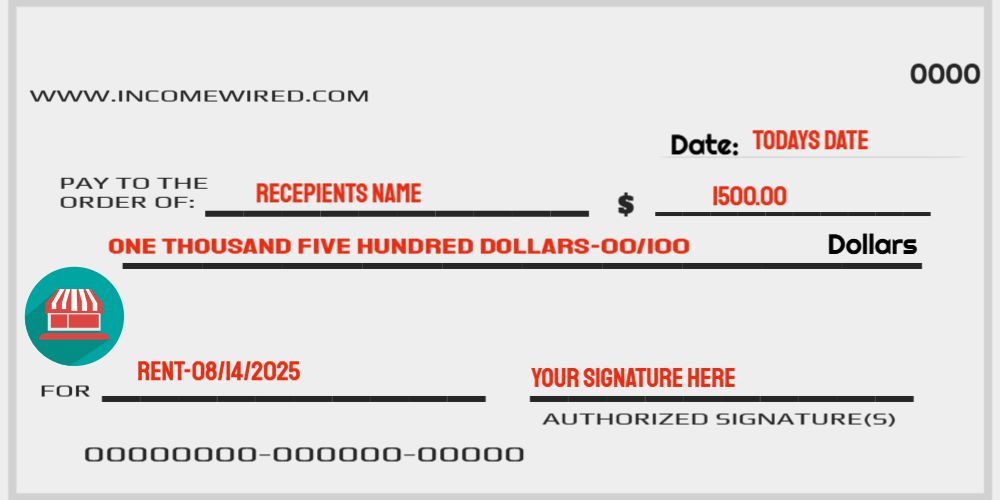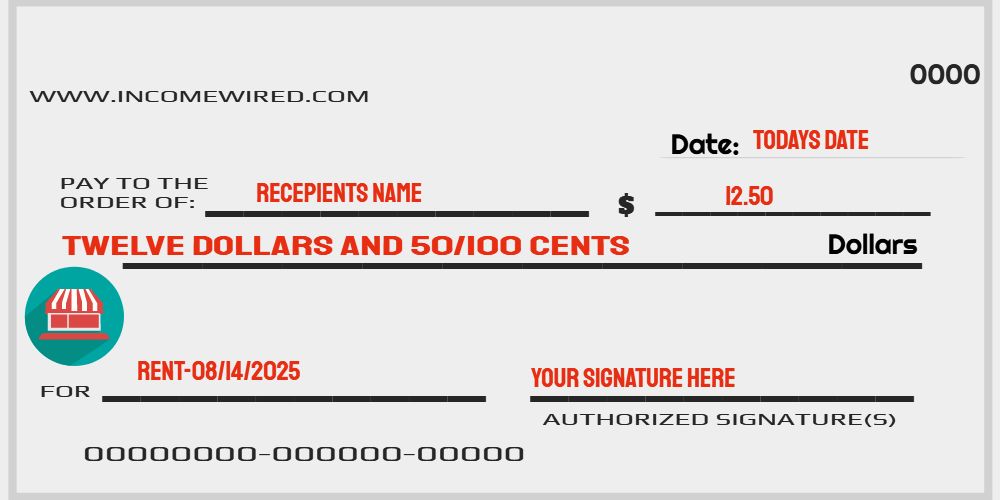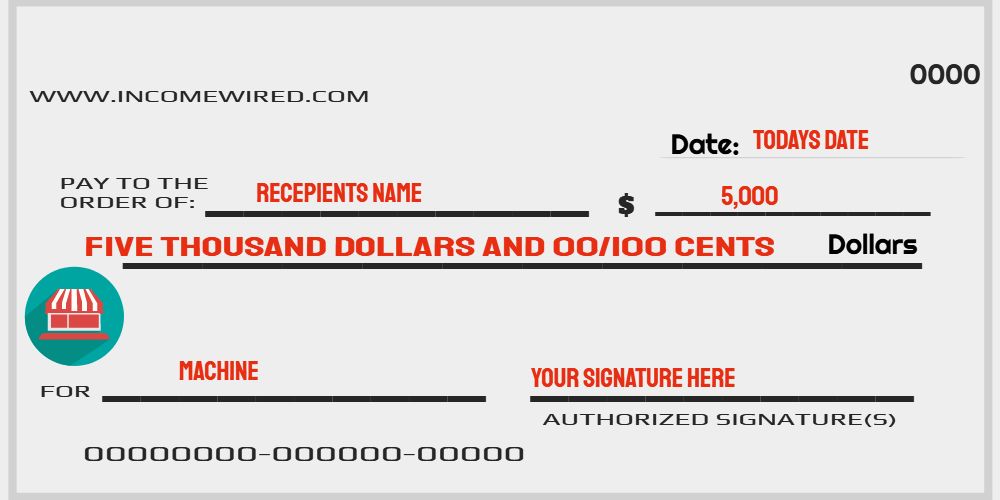we help service-based business owners, freelancers, and aspiring businesses with our content & services & When readers purchase services discussed on our site, we often earn affiliate commissions that support our work. Find out more about Income Wired
In a world where online transactions are becoming the norm, it’s easy to forget the humble check. Yet, there are still times when writing a check is necessary – perhaps you’re paying a small business or making a donation to a charity. Regardless of the reason, it’s crucial to know how to write a check amount in words with cents correctly. After all, the last thing you want is for your hard-earned money to go missing due to a simple error!
In this comprehensive guide, we’ll walk you through everything you need to know about writing a check amount in words with cents. We’ll cover the basic rules, such as writing the dollar amount in words and adding the word “and,” as well as writing the cents as a fraction of 100 and including the word “cents.” But that’s not all – we’ll also explore exceptions and special cases, including how to write large amounts with thousands or millions, how to write amounts with zero cents, and how to write amounts less than one dollar.
Of course, it’s easy to make mistakes when writing a check, which is why we’ll also dive into common errors to avoid. From misspelling words to forgetting to include cents, we’ll help you steer clear of common pitfalls that can result in lost money or confusion. Plus, we’ll offer practical tips for writing a check amount in words with cents with ease, such as double-checking the amount, writing legibly, and using a pen with black or blue ink.
By the end of this article, you’ll be equipped with all the knowledge you need to write a check amount in words with cents like a pro. So, whether you’re writing a check for the first time or just need a refresher, let’s get started!
Basic rules for writing a check amount in words with cents
Writing a check amount in words with cents may seem daunting, but it’s actually quite simple if you follow a few basic rules. These rules are essential to ensure that the correct amount is transferred from your account to the recipient.


A. Writing the dollar amount in words
The first rule is to write the dollar amount in words. This is done in the line that reads “Pay to the Order of.” For example, if you are writing a check for $42.75, you would write “Forty-two dollars and 75/100.” It’s important to note that the word “dollars” should always be included when writing the dollar amount in words.
B. Adding the word “and”
After writing the dollar amount in words, add the word “and” before the cents. This is to indicate that you are transitioning from dollars to cents. For example, you would write “Forty-two dollars and 75/100.” It’s important to note that the word “and” should always be included when writing a check amount in words with cents.
C. Writing the cents as a fraction of 100
The next rule is to write the cents as a fraction of 100 after the word “and.” This means that the cents are written as a number over 100. For example, if you are writing a check for $42.75, you would write “Forty-two dollars and 75/100.” In this case, 75 is the numerator and 100 is the denominator.
D. Including the word “cents”
To indicate the unit of currency being used, include the word “cents” after the fraction. For example, you would write “Forty-two dollars and 75/100 cents.” This clarifies that you are writing a check amount in dollars and cents.
E. Examples for clarification
To help you better understand these rules, let’s look at a few examples:


- $12.50 would be written as “Twelve dollars and 50/100 cents.” This means that 50 cents is half of a dollar, or 50/100 of a dollar.
- $27.83 would be written as “Twenty-seven dollars and 83/100 cents.” This means that 83 cents is just under a dollar, or 83/100 of a dollar.
It’s essential to follow these basic rules when writing a check amount in words with cents to ensure accuracy and avoid confusion. Remember to write the dollar amount in words, add the word “and,” write the cents as a fraction of 100, and include the word “cents.” By following these rules and practicing with examples, you’ll be able to write a check amount in words with cents with ease.
Exceptions and special cases
There are some exceptions and special cases when writing a check amount in words with cents:
When it comes to writing a check amount in words with cents, it’s important to know that there are exceptions and special cases that require a slightly different approach. Let’s take a closer look at these cases and explore how to handle them correctly.
A. Writing large amounts with thousands or millions
If you’re writing a check for a large amount, such as $5,000, you’ll need to adjust your writing slightly. In this case, you would write the dollar amount in words first, followed by “and 00/100 cents.” For example, you would write “Five thousand dollars and 00/100 cents.” If you’re dealing with even larger amounts, such as millions of dollars, you’ll follow the same format, such as “Five million dollars and 00/100 cents.” The key here is to remember to include the word “dollars” after the amount in words.
B. Writing cents as zero
In some cases, there may not be any cents involved in the transaction. In this case, you’ll need to write “Zero cents” after the dollar amount in words. For example, if you’re writing a check for $100 even, you would write “One hundred dollars and 00/100 cents.” Writing “Zero cents” in this case serves as a confirmation that you’ve considered the cents and that the transaction is for a whole dollar amount.
C. Writing amounts less than one dollar
If you’re writing a check for an amount less than one dollar, the basic rules still apply. However, you won’t need to write the dollar amount in words, only the cents. For example, if you’re writing a check for 50 cents, you would write “Fifty cents” on the line that reads “Pay to the Order of.” This approach is straightforward, and it’s essential to be mindful of the unit of currency being used.
D. Writing amounts with only cents
Sometimes, you may need to write a check for an amount that only includes cents, such as 25 cents. In this case, you would write the cents as a fraction of 100 with the word “cents” at the end. For example, you would write “25/100 cents” on the line that reads “Pay to the Order of.” This approach is simple and ensures that the recipient knows exactly how much money is being transferred.
E. Examples for clarification
Let’s take a look at a few examples of these exceptions in practice:


- $5,000 would be written as “Five thousand dollars and 00/100 cents.”
- $0.50 would be written as “Fifty cents.”
- $0.25 would be written as “25/100 cents.”
It’s essential to remember these exceptions and special cases when writing a check amount in words with cents. By being aware of these nuances, you can ensure that your transactions are accurate and clear, without any confusion or errors.
IV. Common mistakes to avoid
While writing a check may seem like a straightforward task, there are some common mistakes to avoid when writing the check amount in words with cents. These mistakes can lead to confusion or errors, potentially resulting in lost money or an incorrect transaction. Let’s take a closer look at these mistakes and how to avoid them.
A. Misspelling
Misspelling words can lead to confusion or errors in the amount being written. For instance, writing “Fourty-two dollars and 75/100 cents” instead of “Forty-two dollars and 75/100 cents” can result in the check being rejected or confusion between the two amounts. It’s important to double-check the spelling of the dollar amount in words and the word “cents” to ensure accuracy.
B. Writing the dollar amount incorrectly
Writing the wrong dollar amount in words can also lead to confusion or errors. For example, writing “Fifty-two dollars and 25/100 cents” instead of “Fifty dollars and 25/100 cents” can result in the wrong amount being transferred. Always take your time and double-check the amount before writing it in words.
C. Forgetting to include cents
Forgetting to include the cents can result in a different amount being transferred than what was intended. Make sure to always include the cents, even if it’s only zero cents. Forgetting to include the cents can also result in the check being rejected or confusion between the two amounts.
D. Writing cents as a decimal
Writing cents as a decimal, such as $42.75 instead of “Forty-two dollars and 75/100 cents,” can lead to confusion or errors in the amount being transferred. Always write the cents as a fraction of 100 to ensure that the correct amount is being transferred. Writing the amount in words also reduces the risk of fraudulent activity, as it’s harder to alter the written amount than a numeric one.
E. Examples for clarification
Let’s take a look at a few examples of these common mistakes to avoid:
- Misspelling: Writing “Fourty-two dollars and 75/100 cents” instead of “Forty-two dollars and 75/100 cents.”
- Writing the dollar amount incorrectly: Writing “Fifty-two dollars and 25/100 cents” instead of “Fifty dollars and 25/100 cents.”
- Forgetting to include cents: Writing “Fifty dollars” instead of “Fifty dollars and 00/100 cents.”
- Writing cents as a decimal: Writing “$42.75” instead of “Forty-two dollars and 75/100 cents.”
To avoid these common mistakes, it’s important to take your time and double-check the written amount before finalizing the check. It’s also helpful to have a reference guide, such as this article, to ensure accuracy and clarity. By avoiding these mistakes, you can write a check amount in words with cents with confidence and ease.
Tips for writing a check amount in words with cents
When it comes to writing a check amount in words with cents, it’s essential to follow the basic rules, as we discussed earlier. However, there are also some helpful tips that can make the process easier and more accurate. Let’s take a closer look at these tips:
A. Double-checking the amount written on the check
Before writing the check, it’s important to double-check the amount being transferred to ensure accuracy. This will help you avoid mistakes or confusion, and it’s especially crucial when dealing with large amounts. Make sure to confirm the amount with the recipient, if necessary, to ensure accuracy.
B. Writing the check amount in the correct location
When writing the check amount in words with cents, make sure to write it in the correct location on the check. This is typically on the line that reads “Pay to the Order of.” Writing the amount in the wrong location can lead to confusion or errors, so it’s essential to be mindful of where you’re writing it.
C. Using a pen with black or blue ink
Using a pen with black or blue ink will ensure that the check can be read clearly. Avoid using other colors or pencils, as they may not be as legible or may be more easily altered. It’s also important to make sure the pen is working correctly and not running out of ink.
D. Writing legibly and clearly
Write the check amount in words with cents legibly and clearly to avoid confusion or errors. If your handwriting is difficult to read, consider writing more slowly or practicing your penmanship. Illegible writing can cause issues, and the recipient may have trouble deciphering the written amount.
E. Examples for clarification
Let’s take a look at a few examples of these tips in practice:
- Double-checking the amount: Check the amount being transferred before writing the check, such as $42.75.
- Writing in the correct location: Write the check amount in words with cents in the correct location on the check, such as “Forty-two dollars and 75/100 cents” on the line that reads “Pay to the Order of.”
- Using a pen with black or blue ink: Use a pen with black or blue ink to write the check amount in words with cents clearly.
- Writing legibly and clearly: Write the check amount in words with cents legibly and clearly to avoid confusion or errors.
By following these tips, you can ensure that your check amount in words with cents is accurate, clear, and easy to read. These tips can help you avoid mistakes or confusion, making the process simpler and more efficient.
Writing a check may seem like a thing of the past, but it’s still a common and necessary practice in many situations. Whether you’re paying a bill, making a donation, or transferring funds, writing a check amount in words with cents accurately is important to ensure that the correct amount is transferred from your account to the recipient. By following the rules, being mindful of exceptions and special cases, avoiding common mistakes, and utilizing helpful tips, you can write a check with confidence and ease.
In conclusion, writing a check amount in words with cents is a simple yet important task that should be taken seriously. By following the guidelines and being mindful of the details, you can ensure accuracy, avoid confusion or errors, and make the process easier and more efficient. With this knowledge, you can confidently write a check and complete your financial transactions with ease.


